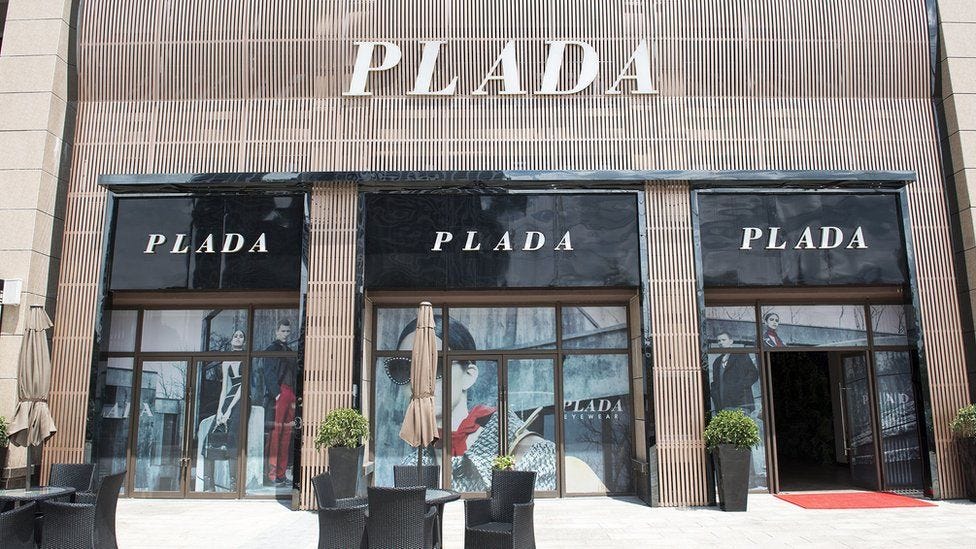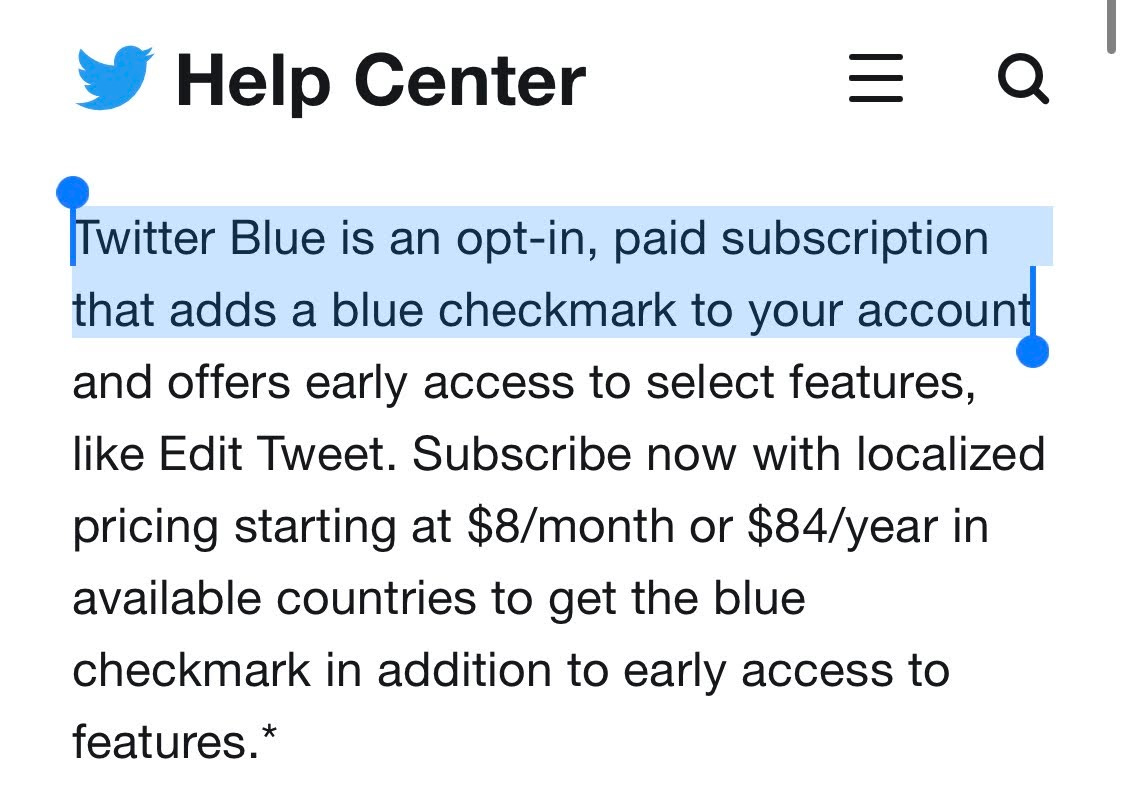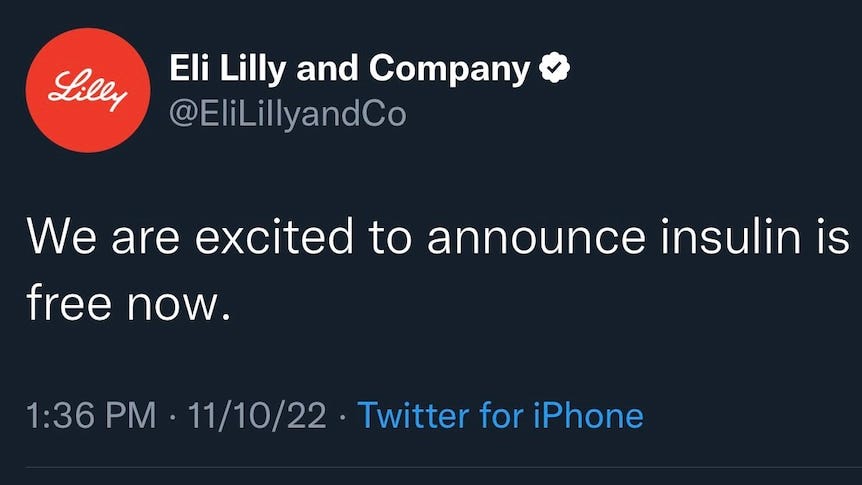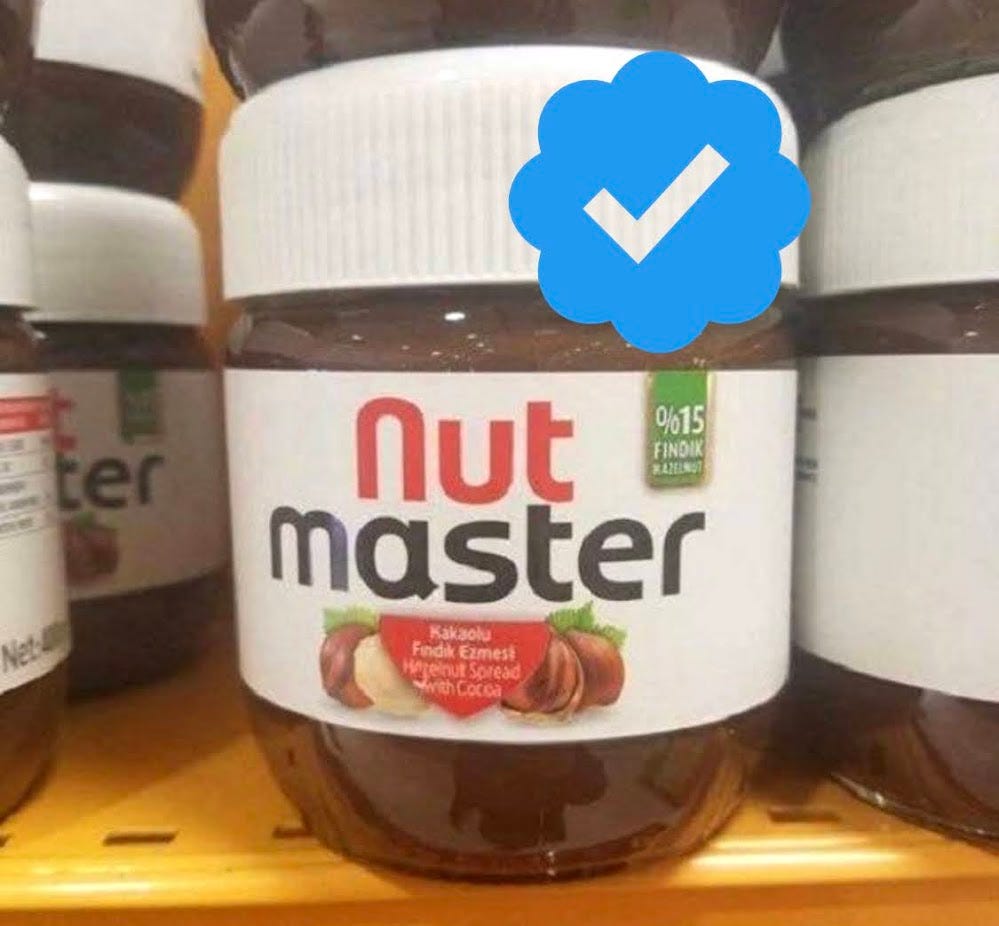"Please just take the checkmark away!" How Twitter devalued a status symbol
Lessons from the case of Twitter Blue
Unpopular opinion: Twitter Blue is a decent product.
I mean that literally — it’s a very unpopular opinion. Twitter users have reached a general consensus that there’s something embarrassing about paying for Blue. Around 97% of previously verified users, including many of the platform’s largest, have refused to sign up, while accounts from The New York Times to Matthew Yglesias have publicly expressed their aversion (with the former getting their checkmark revoked as a penalty).
But Blue is a decent product, with features like the ability to edit tweets, which people have requested for years. So why the mass shunning?
There are many reasons, but a big one is messaging. While the legacy blue checkmark was positioned as a luxury good, the new Twitter Blue became marketed like an inferior good. Twitter’s messaging antagonized and humiliated influential users, made the product feel like it was made for arriviste social climbers instead of respected power users, and framed it as a cheap imitation of an old status symbol rather than a fresh offering with useful benefits.
In this post, we’ll look at why Twitter Blue wasn’t positioned for success and what it can do now to win over users. In the process, we’ll see three important comms lessons:
How to position something as a luxury item
How a luxury item loses its cachet
How to sell a mass-market product
The making of a status symbol
In economics, luxury goods are things that people are more likely to buy when they have more money (because they can). In contrast, inferior goods are things that people are less likely to buy when they have more money (because they don’t need to). These terms refer to buyer behavior, not quality, so for clarity we’ll refer to inferior goods as “mass-market” or “practical” products.
The legacy checkmark was a luxury good, a status symbol. That seems counterintuitive because it was free. But on Twitter, the primary currency is social — status comes not from money, but from followers and influence. The rich folks on Twitter are those with big followings, and the free checkmark procured with social currency was worth more than the new checkmark bought with dollars.
That brings us to…
Comms lesson #1: How to position something as a luxury item
Twitter successfully positioned its legacy blue check as a luxury item by:
Targeting the right audience
The legacy verification program focused on public figures, celebrities, politicians, journalists, and influencers who tend to have the biggest followings.
Offering a clear value proposition
Twitter always highlighted that the blue check stood for credibility and authority, which marked its owner as “notable” and famous enough to have impersonators.
Establishing a distinct visual brand
The blue checkmark was widely recognized.
Creating exclusivity
The limited availability created a sense of scarcity. Luxury items have a high bar for access (typically you’d need a lot of money; in this case you’d need a lot of social standing). Brands like Tommy Hilfiger or Under Armour became seen as less prestigious after they showed up in discount stores.
Serving “insiders”
IYKYK. It’s why Loro Piana clothes don’t have a visible logo and why some credit cards can’t be applied for because they’re invitation-only. The opaque and inconsistent way Twitter verified users may have been unfair, but it added to the perceived prestige of the blue check.
Winning over influencers
Luxury brands get celebrities and other brand ambassadors to promote brands to their followers — think Harry Styles for Gucci. With the legacy blue check program, Twitter gave white-glove service to high-profile users and got them talking about their verification process.
Making people feel special
Luxury brands create emotional appeal by evoking a sense of accomplishment, and getting the blue check made people feel “notable.”
Protecting authenticity at all costs
The main purpose of Twitter’s blue check program was to verify real identities, and authenticity is central to prestige. There’s a reason luxury brands are fanatical about cracking down on counterfeits. High-end products get cheapened by an association with low-quality fakes; Prada customers don’t want to carry a bag that looks like it could be a Plada.
But cachet is hard to gain and easy to lose. Here’s what happened next.
The problem: Twitter Blue was marketed like an inferior wannabe
Blue was, commendably, designed to be democratic and widely accessible. It could have easily become a normal mass-market product, marketed to the general population on the basis of its own benefits and value.
Instead, Blue ended up being perceived as an inferior good, like a knockoff luxury item, because of three key decisions on its branding:
Using the same blue checkmark as the legacy verification program
The Passat is a great car. But imagine if the Volkswagen Group made a Passat that looked just like a Porsche. The Passat would attract customers who couldn’t otherwise drive a luxury car, while rich people would abandon the Porsche so their peers wouldn’t think they were driving a Passat.
Not killing the legacy checkmark before rolling out Blue
By allowing the legacy verified checkmarks to coexist with the Blue checkmarks, Twitter created negative incentives. Very few legacy “notable” people signed up for Twitter Blue, because they already had the checkmark that was marketed as the marquee feature of Blue. Instead, they loudly complained about Blue, both to vent about being asked to pay for something they previously had for free and to certify their legacy “notable” status.
It got so bad that Twitter changed their popup to give cover for Blue subscribers, but it’s only going to prompt legacy verified people to post more tweets avowing they did not and would never sign up for Blue. What Twitter needs to do is kill the blue check entirely (see Comms lesson #3).
Focusing disproportionate attention on the checkmark as a feature
The marketing of the blue checkmark as a Blue benefit made it look like anyone who signed up for Blue was pursuing a backdoor to a status symbol. Twitter should have just marketed the new product as a nice practical Casio, but their messaging made it feel like a fake Rolex. And while no one would give you a hard time for wearing a regular Casio, prepare for a red-hot roast if you’re called out trying to stunt with a fake Rolex.
Comms lesson #2: How to make a luxury item lose its cachet
On top of that misaligned framing, Twitter Blue suffered from comms decisions that eroded its cachet:
Stoking resentment among big accounts
Not only were there no special offers or outreach to encourage big accounts with legacy blue checks to convert, but those users were mockingly told to pay up or lose the blue check. It invited defiance and dumped chips on shoulders. It gave these users an incentive to prove that they actually couldn’t care less about the blue check. (I know a core tenet of Blue is that “no one gets special treatment,” but that doesn’t work in influencer marketing, and big accounts get special treatment all the time anyway.)
Off-key messaging
As I noted above, the marketing for Blue focused on the blue check, which again made Blue feel like a knockoff of a luxury item for status-seekers. In addition, the messaging centered on what Blue could do for the company (generate revenue) instead of what it could do for customers (improve their tweets and grow their following).
Over-saturation
The value of the blue check was partly driven by scarcity. By verifying accounts indiscriminately en masse, Twitter removed its sense of exclusivity and prestige.
Association with distasteful figures
The most damage dealt to the blue check comes not from media hit pieces, but from appearing next to some anonymous user with 8 followers who just posted an anti-Semitic screed or a link to win crypto.
Proliferation of fakes
Twitter Blue users no longer have to prove their real identity to get the blue check. The checkmark is now associated with fakes, especially after viral impersonation incidents like the Eli Lilly fiasco.
These things ultimately led to the flood of tweets from legacy blue checks distancing themselves from Twitter Blue.
The solution: A new strategy
Mass-market products can be just as successful as luxury goods, but they have to be marketed differently. Here are some ways that Twitter Blue — or any other mass-market product — can appeal to customers and thrive as a good solid Casio.
Comms lesson #3: How to sell a mass-market product
Know your target audience
Home in on potential customers and brand ambassadors: Market specifically to Twitter users who are highly engaged and willing to pay for a premium experience, e.g., people or organizations who tweet a lot and want an extra boost to grow their followings. The company could personally reach out to top accounts to brief them on new features, extend special offers, and solicit their feedback.
Reset relations with legacy blue checks: Crucially, since Twitter has already alienated many legacy blue check holders by painting them as the pompous old guard, this would require a cessation of hostilities (ending the open mockery and trolling of top users) and a reset or peace offering, like a free trial of the new product. Some are irreversibly hostile to the company or its owner, but many could be persuaded to give Blue another chance.
Tailor the messaging: Create comms and advertising campaigns that speak to existing verified users and big accounts that could be potential new subscribers. Understand their preferences, pet peeves, and cultural erogenous zones.
Get the messaging right
Publicize the value proposition: Position the product as being for people who are serious about quality content, not chasing a status symbol. Move the messaging for Blue away from any talk of checkmarks, and emphasize practical benefits like more reach, bookmark folders, the ability to edit or undo tweets, and priority customer support.
Document outcomes for users: Share examples of users seeing higher growth and a better experience after subscribing to Blue, including people who already had the legacy checkmark but leveled up after getting Blue’s premium features.
Focus on quality and reliability: Address the initial glitches and reassure users that the product is now reliably meeting or surpassing expectations.
Create a strong brand identity
Differentiate the offering: In all communications, draw a clear distinction between the legacy verification program (authenticity) and the Twitter Blue subscription (premium features). Avoid confusion and baggage associated with the blue check.
Have a clear visual identity: Rebrand. Kill the checkmark. Create a new visual badge for Twitter Blue, separate and distinct from any badge denoting a verified identity. If people are building Chrome extensions to expose and embarrass users who paid for your product, you need a rebrand for your product.
Foster brand loyalty: Cultivate a persona and tone that will appeal to target customers. Consistently deliver on promises, to build customer trust and loyalty.
Get users to promote the product
Curate early adopters: Carefully select and target the initial batches of influential users — they should be the people and organizations that subsequent users aspire to emulate (for all its later failings, Clubhouse did this brilliantly in the beginning).
Collaborate with influencers: Give free subscriptions to legacy verified users or large accounts. Work with influencers to endorse the product to their networks — in an understated and natural way, so they don’t get ridiculed for it, especially now while the brand is shaky.
Encourage testimonials: Positive word-of-mouth helps establish trust and credibility. Encourage and incentivize satisfied users to share their experiences through reviews and testimonials (with a paid product, it’s easy to offer the most engaged users a free month for reviewing the product and “supporting the Blue community” or whatever).
Hold the line
Be aggressive about social listening and fact checking: Actively offer clarification and correct false rumors about the product. Use an official account (e.g., @TwitterBlue) where possible, so the exchanges don’t become personal.
Monitor user feedback: Keep a close eye on user feedback and quickly address any concerns or confusion before FUD can spiral out of control.
Maintain standards: Don’t say “This account is verified” if it isn’t verified. Twitter should regularly review accounts with special badges to make sure they’re not sketchy or scammy.
Fight the negative with the positive
Create content: You can’t erase negativity, but you can inject positivity. To showcase the product’s benefits, develop engaging content like videos, threads, case studies from users, how-to guides, Twitter Spaces, and longer posts.
Hijack competitors: Create content designed to infiltrate competitor social networks, and use it to advertise the benefits of your product to win over users from competing platforms.
Media outreach: This is not how Twitter rolls, but other companies may benefit from selectively building relationships with journalists and sharing updates and success stories.
Twitter’s transition from the prestigious legacy blue check to the more practical Blue subscription is a case study for any company looking to build and maintain desire for a product — and the shunning of Blue shows just how dicey this can be. But, as Twitter has also shown, it’s never too late for a second act.















Very good article. One more point. They should stop saying verified at all. It's not a verified account. It's a premium account.
Also, most of the value of Twitter is from the tweets of the former verified people. Tweets from Stephen King get folks to come to Twitter because they know that's it's the real Stephan King. Once hes gone or not longer verifiable (because they don't verify people any more) the value of Twitter goes down.
To put it another way, whether you like Fox news or CNN, the value of their news is lessoned by not knowing if it's really coming from Fox News or CNN.
This is smart. Elon seems to want is to antagonize legacy blue checks more than he cares about pursuing a smart strategy for Twitter.